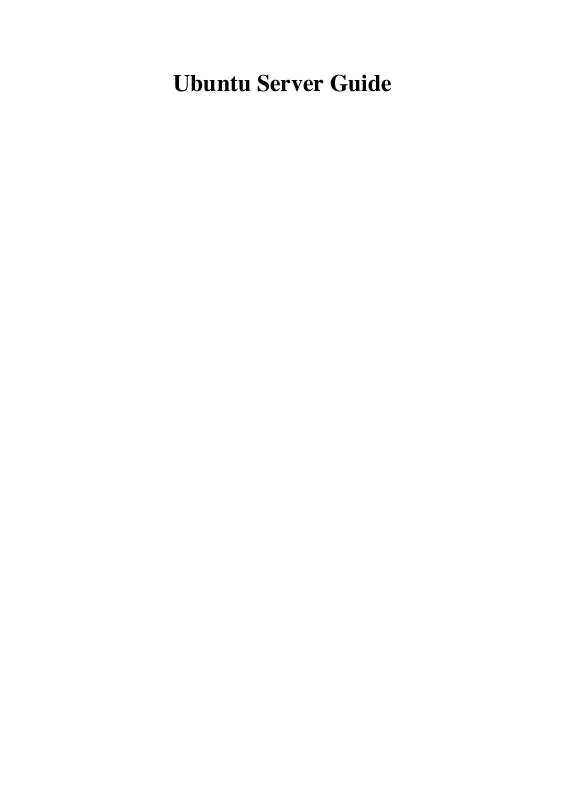User manual UBUNTU 9.10 SERVER GUIDE
Lastmanuals offers a socially driven service of sharing, storing and searching manuals related to use of hardware and software : user guide, owner's manual, quick start guide, technical datasheets... DON'T FORGET : ALWAYS READ THE USER GUIDE BEFORE BUYING !!!
If this document matches the user guide, instructions manual or user manual, feature sets, schematics you are looking for, download it now. Lastmanuals provides you a fast and easy access to the user manual UBUNTU 9.10. We hope that this UBUNTU 9.10 user guide will be useful to you.
Lastmanuals help download the user guide UBUNTU 9.10.
Manual abstract: user guide UBUNTU 9.10SERVER GUIDE
Detailed instructions for use are in the User's Guide.
[. . . ] Ubuntu Server Guide
Ubuntu Server Guide
Copyright © 2008 Canonical Ltd. and members of the Ubuntu Documentation Project3 Abstract Welcome to the Ubuntu Server Guide!It contains information on how to install and configure various server applications on your Ubuntu system to fit your needs. It is a step-by-step, task-oriented guide for configuring and customizing your system.
Credits and License
This document is maintained by the Ubuntu documentation team (https://wiki. ubuntu. com/DocumentationTeam). [. . . ] · The DirectoryIndex is the default page served by the server when a user requests an index of a directory by specifying a forward slash (/) at the end of the directory name. For example, when a user requests the page http://www. example. com/this_directory/, he or she will get either the DirectoryIndex page if it exists, a server-generated directory list if it does not and the Indexes option is specified, or a Permission Denied page if neither is true. The server will try to find one of the files listed in the DirectoryIndex directive and will return the first one it finds. If it does not find any of these files and if Options Indexes is set for that directory, the server will generate and return a list, in HTML format, of the subdirectories and files in the directory. The default value, found in /etc/apache2/apache2. conf is " index. html index. cgi index. pl index. php index. xhtml". Thus, if Apache2 finds a file in a requested directory matching any of these names, the first will be displayed. · The ErrorDocument directive allows you to specify a file for Apache to use for specific error events. For example, if a user requests a resource that does not exist, a 404 error will occur, and per Apache2's default configuration, the file /usr/share/apache2/error/HTTP_NOT_FOUND. html. var will be displayed. That file is not in the server's DocumentRoot, but there is an Alias directive in / etc/apache2/apache2. conf that redirects requests to the /error directory to /usr/share/apache2/
error/.
To see a list of the default ErrorDocument directives, use this command:
grep ErrorDocument /etc/apache2/apache2. conf
· By default, the server writes the transfer log to the file /var/log/apache2/access. log. You can change this on a per-site basis in your virtual host configuration files with the CustomLog directive, or omit it to accept the default, specified in /etc/apache2/apache2. conf. You may also specify the file to which errors are logged, via the ErrorLog directive, whose default is /var/log/apache2/ error. log. These are kept separate from the transfer logs to aid in troubleshooting problems with your Apache2 server. You may also specify the LogLevel (the default value is "warn") and the LogFormat (see /etc/apache2/apache2. conf for the default value). · Some options are specified on a per-directory basis rather than per-server. A Directory stanza is enclosed in XML-like tags, like so:
<Directory /var/www/mynewsite> . . .
134
Web Servers
</Directory>
The Options directive within a Directory stanza accepts one or more of the following values (among others), separated by spaces: · ExecCGI - Allow execution of CGI scripts. CGI scripts are not executed if this option is not chosen. Most files should not be executed as CGI scripts. CGI scripts should kept in a directory separate from and outside your DocumentRoot, and only this directory should have the ExecCGI option set. This is the default, and the default location for CGI scripts is /usr/lib/cgi-bin. · Includes - Allow server-side includes. Server-side includes allow an HTML file to include other files. See the Apache2 SSI HOWTO4 for more information. [. . . ] Screen Profiles
One of the most useful applications for any system administrator is screen. It allows the execution of multiple shells in one terminal. To make some of the advanced screen features more user friendly, and provide some useful information about the system, the screen-profiles package was created. When executing screen for the first time you will be presented with the screen-profiles-helper menu. [. . . ]
DISCLAIMER TO DOWNLOAD THE USER GUIDE UBUNTU 9.10 Lastmanuals offers a socially driven service of sharing, storing and searching manuals related to use of hardware and software : user guide, owner's manual, quick start guide, technical datasheets...manual UBUNTU 9.10


